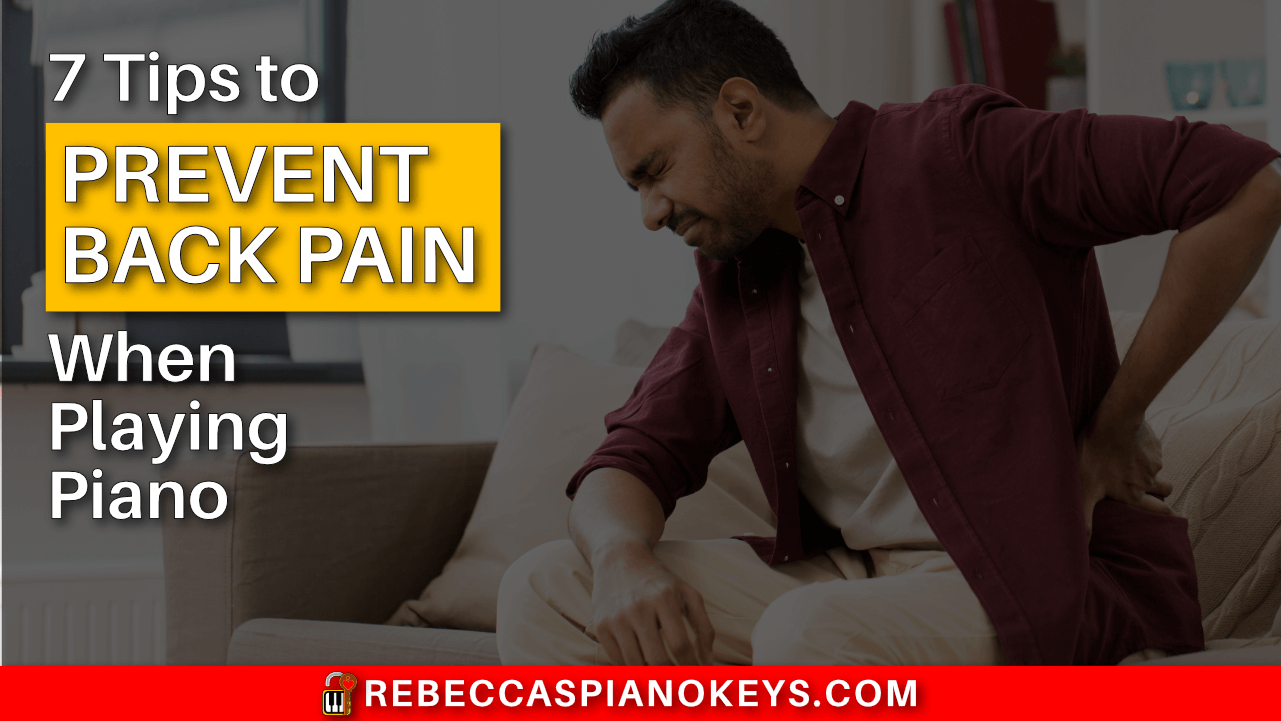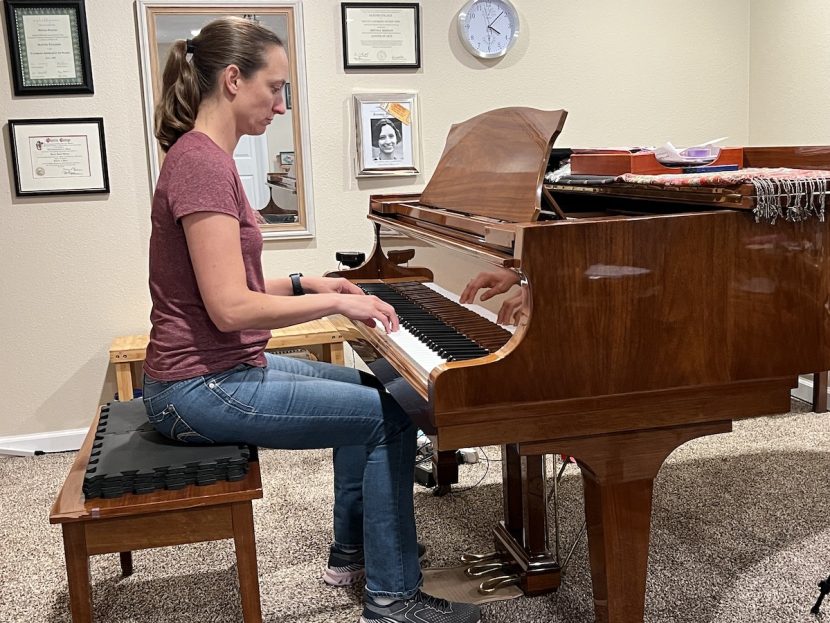Yes, playing the piano can cause back pain if done with poor posture. Prolonged sitting and repetitive movement may contribute to discomfort.
In the meantime, don't forget to unlock a world of unlimited sound with Amazon Music Unlimited, where over 100 million songs wait at your fingertips. Whether you're working, relaxing, or fueling your creativity, the right track is always just one tap away. Elevate every moment with music that moves you.
Mastering the piano requires dedication, practice, and a good deal of time seated at the keyboard. That’s why maintaining proper posture is not just important for technique; it’s crucial for preventing physical strain. As pianists immerse themselves in the complexities of their music, the focus can shift from maintaining a healthy posture to perfecting the music, sometimes leading to back pain.
Ensuring regular breaks, stretching, and ergonomic seating can reduce this risk. A well-rounded approach includes mindfulness of posture, balanced practice sessions, and appropriate physical care to support both health and musical excellence.

Credit: rebeccaspianokeys.com
The Link Between Piano Playing And Back Pain
Many pianists experience back pain. This may surprise some. You might think sitting and playing piano is relaxing. Often, it is not. The back pain pianists feel has a few causes. We will explore them here. Our focus is on how playing the piano can both soothe and strain.
Physical Demands Of Musicianship
Piano playing is about more than fingers on keys. It demands full-body involvement. A pianist’s posture, how they sit, and movement patterns all play roles. Pianists engage their whole body when they play. This can lead to stress in their back, shoulders, and neck. Consider this:
- Long hours in a fixed position
- Repetitive arm and hand movements
- Engaging back muscles for control
All the above strain the body. The back is no exception.
Common Postural Mistakes At The Piano
Sitting wrong can lead to pain. Correct posture is key for pianists. Many make common mistakes. These include:
- Slouching or leaning too far forward
- Placing the bench too high or low
- Reaching too far for keys
Sit right, and you may prevent pain. A straight back, with feet flat on the floor helps. Keep wrists relaxed and elbows at the right angle. The aim is a comfortable, pain-free performance.
Recognizing these factors is valuable. It can guide pianists to healthier practices. This promotes enjoyment and longevity in their musical pursuits.
Anatomical Insights Into Pianists’ Back Pain
Understanding how playing the piano can affect your back unlocks the puzzle behind many pianists’ pain. Precise movements and long hours of practice can cause stress on the body. Let’s dive into the anatomical side of this issue.
Muscle Strain And Repetitive Stress Injuries
Playing the piano involves repetitive motion. This motion can tire your muscles. Sore muscles can lead to back pain for pianists. Good posture is key to avoid strain.
- Common strained muscles include the trapezius and latissimus dorsi.
- Long practice sessions increase injury risk.
- Using ergonomic benches helps reduce muscle fatigue.
Rest and proper techniques are important. They keep your muscles healthy.
Spinal Alignment And Its Impact On Pianists
Sitting for long can harm your spine. Your spine supports your body. A bad posture can cause back pain.
| Correct Spine Position | Incorrect Spine Position |
|---|---|
|
|
Spinal alignment is vital for pianists. It prevents back pain. Adjust your piano bench. Ensure your feet are flat on the floor. Keep your back straight.
Personal Accounts From Pianists
The piano’s harmonious melodies sometimes come with a less pleasant accompaniment: back pain. It’s not uncommon for regular sessions of musical expression to lead to discomfort. Here, we tune into real-life stories from pianists who have faced this issue themselves.
Experiences Of Professional Pianists With Back Pain
For professionals, playing the piano isn’t just a hobby, it’s often a daily demand. Long hours at the keyboard mean their experiences with back pain offer valuable insights into how serious the issue can be.
- Extended rehearsals leading to chronic strain
- Adjusting posture to minimize pain
- Seeking out physical therapy and ergonomic aids
| Pianist | Years of Experience | Back Pain Onset | Coping Mechanism |
|---|---|---|---|
| John Doe | 10 | 5 years in | Yoga, Regular Breaks |
| Jane Smith | 15 | 7 years in | Ergonomic Bench, Physical Therapy |
| Emily Jones | 20 | 10 years in | Corrective Exercises, Posture Adjustments |
These experiences highlight not only the commonality of the issue but also the diversity of solutions that professionals have to adopt.
How Amateur Players Deal With Discomfort
Amateur pianists may not log as many hours, but their back pain is no less real. They often have to figure out cost-effective and time-saving solutions.
- Acknowledging the first signs of discomfort
- Identifying incorrect posture and seating positions
- Implementing short-term relief measures like heating pads
- Adopting lifestyle modifications
Adjustable benches and regular stretch breaks are among the everyday strategies employed by hobbyists to relieve pain and prevent injury.
Preventative Measures And Ergonomics
Many pianists feel the music in their fingers, but sometimes, they also feel pain in their backs. Preventing back pain is key to enjoying the piano long-term. Ergonomics and the right habits can make all the difference.
Adjusting The Piano Bench For Optimal Posture
Good posture starts with adjusting your bench. The bench height should let your elbows sit comfortably at keyboard level. Your feet must rest flat on the floor, forming a 90-degree angle at the knees.
| Bench Adjustment | Posture Benefit |
|---|---|
| Height | Aligns elbows and hands with keys |
| Distance | Allows comfortable reach of keys |
| Angle | Supports natural back posture |
Incorporating Breaks And Stretches Into Practice
Long practice sessions can strain your back. Regular breaks and stretches are essential to relax your muscles.
- Take short breaks every 20-30 minutes.
- Stand up and walk to boost blood flow.
- Practice stretches that target your back and shoulders. These will help to loosen tight muscles.
Simple stretches can include reaching for the sky or gently twisting your torso from side to side. Pay attention to your body, and don’t push into pain.
Treatment And Management Strategies
Encountering back pain from piano playing is not uncommon. The key lies in effective treatments and management strategies. A combination of physical therapy and exercises tailored to pianists can offer relief. Alternative therapies also serve as potential solutions for managing discomfort. Understanding and applying these strategies can reduce pain and enhance your playing experience.
Physical Therapy And Exercises For Pianists
Pianists require a routine that targets their unique physical demands. Physical therapy focuses on optimizing posture and strengthening the muscles. Exercises concentrate on flexibility and support. Here are strategies proven beneficial:
- Stretching: It promotes muscle flexibility and reduces tension.
- Strengthening exercises: Core workouts support the back.
- Postural training: Proper alignment is crucial for pianists.
Engage in these activities consistently for the best results. Regular breaks during practice can prevent strain. An ergonomic bench supports proper seating position.
Alternative Therapies And Their Effectiveness
Alternative therapies offer holistic relief options. Their effectiveness varies, yet many find them valuable. Consider the following:
| Therapy | Effectiveness |
|---|---|
| Yoga | Improves flexibility and reduces stress. |
| Massage | Eases muscle tension and promotes relaxation. |
| Acupuncture | Targets specific pain points, offers relief. |
Discuss options with a healthcare provider. What works for one might not work for another.

Credit: www.grandstandforpiano.com
Evolving Approaches In Piano Pedagogy
The art of piano playing continues to evolve, particularly in the realm of teaching methods. Traditional piano pedagogy focused primarily on musicality and technique, often with less consideration for the physical implications of long practice hours. With the rise of performance-related injuries, the spotlight now turns to incorporating physical health within piano education.
Teaching Methods Prioritizing Physical Health
Piano instructors today are rethinking conventional teaching strategies. They promote practices designed to minimize stress and strain. By prioritizing posture, hand positioning, and movement efficiency, these innovative methods help students maintain optimal health.
- Ergonomic bench positioning
- Regular breaks during practice
- Tailored exercises to strengthen back and core muscles
These adjustments are crucial for developing a sustainable piano practice that supports a long and healthy musical career.
Technology’s Role In Reducing The Risk Of Injury
Technological advancements now also play a significant role in piano pedagogy. Tools such as adjustable piano benches and digital pianos with weighted keys help cultivate an injury-free environment.
| Technological Aid | Benefit |
|---|---|
| Smartphones & Apps | Monitor practice time and posture |
| Online Tutorials | Access to ergonomic lessons |
| Biomechanical Analysis | Professional feedback on technique |
Embracing these tools helps students to play without pain, ensuring their passion for piano remains joyous and fulfilling.

Credit: majoringinmusic.com
Did Mozart Experience Back Pain from Playing the Piano?
It is widely believed that Mozart’s piano type, the fortepiano, contributed to his back pain while playing. The instrument’s heavy touch and small size required musicians to use a lot of force and sit in a hunched position for extended periods. This likely resulted in Mozart experiencing back pain during his performances.
Frequently Asked Questions Of Can Playing The Piano Cause Back Pain
Why Does My Back Hurt After Playing Piano?
Your back pain after playing piano likely results from poor posture or prolonged sitting. Adjust your bench height and posture, and take regular breaks to alleviate discomfort.
What Are The Side Effects Of Playing Piano?
Playing the piano can initially cause finger and hand fatigue. Over time, poor posture or technique may lead to muscle strain and repetitive stress injuries. Ensuring proper form and taking regular breaks can mitigate these risks.
What Happens If You Play Piano Too Much?
Playing piano excessively can lead to muscle strain or repetitive strain injuries. It may also cause fatigue and physical discomfort. To prevent this, take regular breaks and practice proper technique.
What Is The Most Common Injury In Piano?
The most common injury among pianists is tendinitis, affecting fingers and wrists due to repetitive movements.
Conclusion
Understanding the link between piano playing and back pain is crucial for musicians. Proper posture and regular breaks can mitigate risks. An ergonomic bench and physical exercises also help. For pianists, maintaining back health is as important as mastering melodies.
Prioritize comfort to keep the music flowing pain-free.
{ “@context”: “https://schema.org”, “@type”: “FAQPage”, “mainEntity”: [ { “@type”: “Question”, “name”: “Why does my back hurt after playing piano?”, “acceptedAnswer”: { “@type”: “Answer”, “text”: “Your back pain after playing piano likely results from poor posture or prolonged sitting. Adjust your bench height and posture, and take regular breaks to alleviate discomfort.” } } , { “@type”: “Question”, “name”: “What are the side effects of playing piano?”, “acceptedAnswer”: { “@type”: “Answer”, “text”: “Playing the piano can initially cause finger and hand fatigue. Over time, poor posture or technique may lead to muscle strain and repetitive stress injuries. Ensuring proper form and taking regular breaks can mitigate these risks.” } } , { “@type”: “Question”, “name”: “What happens if you play piano too much?”, “acceptedAnswer”: { “@type”: “Answer”, “text”: “Playing piano excessively can lead to muscle strain or repetitive strain injuries. It may also cause fatigue and physical discomfort. To prevent this, take regular breaks and practice proper technique.” } } , { “@type”: “Question”, “name”: “What is the most common injury in piano?”, “acceptedAnswer”: { “@type”: “Answer”, “text”: “The most common injury among pianists is tendinitis, affecting fingers and wrists due to repetitive movements.” } } ] }
As an Amazon Associate, Cleanestor earns from qualifying purchases at no additional cost to you.

